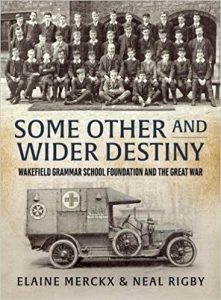Wakefield Grammar School Foundation and the Great War
The Great War took a great toll on the public and grammar schools of Great Britain. Many young men left school in the summer only to be lost to their family and friends by the winter, while others had had careers and families of their own cut short by injuries or death.
‘Some Other and Wider Destiny – Wakefield Grammar School Foundation in the Grear War‘ by Elaine Merckx and Neal Rigby have delved deep into the vast archives of the Foundation to bring photographs, documents, minutes, The Old Savilian (the School magazine) and eyewitness reports together in this study of The Great War and its effect on life in both the boys’ school and Wakefield Girls High School and surrounding city.

Some Other and Wider Destiny cover
The book, nearly 500 pages, informs the reader of the background of both schools telling what life was like at school in Wakefield.
Listed within the pages are the names of approximately 200 ‘Old Girls’ who did work of national importance in various forms. For example, Sophie Appleyard did clerical work at the County Hall, as did Isabella Loudon and Janet Mcqueen Loudon. While Eva Bates was Private Secretary to the Inspector of the Government Shell Factories, Leeds. Marjorie Bygate did work at the United Counties Bank to replace a man at the Front. Many others were part of the VAD (Voluntary Aid Detachment) and did work of varying natures around the country. Some like Nancy Evelyn Walley was nursing in France by 1916. Mabel Kitson, it seems went farther afield, working in the Diplomatic Service at the British Embassy, Washington. She was the first British woman to achieve this and rose to become head of a department. Others stayed local and worked on various committees, did fundraising and volunteer work, including work at Wentworth House, their former school which had been turned into a hospital. Charles Edwin Woodhead, a Private in the Northumberland Fusiliers was a Prisoner of War, as did Austin Ernest Wilson of the KOYLI. A young man named Montagu William Wood did service with the Shanghai Light Horse.
The young men. The ‘Old Boy’s’. The ‘Old Savilians’ who went to war are all named with the years they attended the school, along with their final rank, regiment and any additional information. This information may include their date and place of death; any additional medals awarded i.e. Military Medal; when they enlisted; if they were wounded or invalided.
Most poignant is the Roll of Honour to those who paid the ultimate sacrifice. From Lieutenant-Colonel’s to the humble private each one is remembered and in most cases, a photograph is included.
These men are more than mere names on a page or a memorial, they were someone’s son, a brother, a grandson. They were part of a community, albeit a church or a school. They were part of a team, either cricket or rugby. They were a classmate. They were an ‘Old Savilian’. They were and shall always be part of the fabric of Wakefield Grammar School.
Elaine and Neal have recorded every part of life at both schools leading up to and including the time of the Great War and no research stone seems to have been left unturned. It is a work of great passion and enthusiasm and is a tribute to the school, the boys and themselves. Well done!
To get your copy of ‘Some Other and Wider Destiny – Wakefield Grammar School Foundation in the Grear War‘ published by Helion & Co. Ltd., you can contact either the Wakefield Grammar School office or the publisher. The book is also available on Amazon.